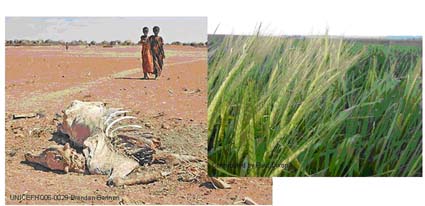Research interests
Research interests
Molecular mechanisms for mineral nutrition and salt/drought tolerance of plants
Why study mineral nutrition and salt/drought tolerance?

One of the major challenges for mankind in this century is to provide enough food for a rapidly expanding world population while preserving ecological and energy resources of our planet. According to the United Nations (2006) the world population will likely grow by 2.5 billion over the next 43 years, passing from the current 6.7 billion to 9.2 billion in 2050. A massive increase in crop production is required to meet the food demands of future generations; in 2020 the world agriculture will have to produce about 3.4 billion tons of cereals per year to meet the global demands. This increase in crop production has to come from -
1. Yield increase on existing arable land, which is limited by the (financial and ecological) costs of irrigation, fertilization and pest/disease control;
2. Expansion of arable land, which is limited by global soil degradation in the form of erosion, nutrient depletion, water scarcity and salinity.
To ensure rapid progress in both directions plant scientists have to work closely together with breeders and ecologists.
The contribution of our laboratory to global food security is to provide an understanding of the molecular mechanisms determining -
1. Nutrient usage efficiency
2. Salt and drought tolerance
3. Interaction between abiotic and biotic stress

Experimental research in the laboratory addresses specific questions in the following areas -
1. Ion & water homeostasis;
2. Systems biology and metabolism;
3. Nutrient sensing and root architecture;
4. Transcriptional regulation and epigenetics;
5. Cross-talk of abiotic and biotic stress responses.
We apply a wide range of techniques and methodologies:
1. Molecular biology and genetics;
2. High-throughput screening and phenomics;
3. Microarrays and Illumina sequencing;
4. ChIP and MeDIP;
5. Microelectrodes and patch (voltage) clamp;
6. Biochemistry and proteomics;
7. Fluorescence imaging and laser microscopy.
Experimental systems used in our research include:
1. Model species (Arabidopsis thaliana);
2. Extremophiles (Thellungiella halophila);
3. Crops (barley, Brassica sp);
4. Heterologous expression systems (Xenopus oocytes, yeast, insect and mammalian cell line.

For more information on research projects and people please visit the laboratory webpage at http://www.psrg.org.uk/

